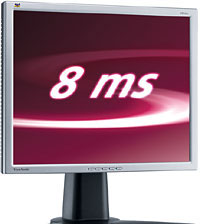 The trouble with CRT monitors is that they often go fuzzy at such a leisurely rate that you don’t notice the deterioration, but find yourself slowly sitting closer and closer to the screen.
The trouble with CRT monitors is that they often go fuzzy at such a leisurely rate that you don’t notice the deterioration, but find yourself slowly sitting closer and closer to the screen.
It was only when we found ourselves virtually snogging the monolithic 21″ Mitsubishi CRT monitor in our office that we decided it might be time for a change.
After much poking and prodding and review-searching, we decided to replace the 21″ beast with two Viewsonic VP191 LCD monitors, each with a native 1,280 x 1,024 resoluton.
They’re by no means the cheapest 19″ flat screen monitors around, but the slimline, ‘thinedge’ profile and image quality were all persuasive factors.
But what really got our wallet creaking open was the Viewsonic’s natty construction which offered enough manoeuvrability to rival a Russian gymnast on a bed of oil.
 Height, pivot, tilt and swivel could all be adjusted effortlessly, so it’s easy to shimmy monitors into the exact desired position – particularly useful if you’re arranging a multi-screen set up.
Height, pivot, tilt and swivel could all be adjusted effortlessly, so it’s easy to shimmy monitors into the exact desired position – particularly useful if you’re arranging a multi-screen set up.
Anyone working on long text documents will soon be spinning the monitor around into portrait mode with a joyful skip in their step because it makes a real difference to productivity – no more scrolling all over the screen!
Viewsonic uses Pivot Pro software to rotate the display from 0 to 270 degrees, and it’s possible to mix and match the orientation in multi monitor set ups. It worked fine every time with no hitches during our testing.
Swivelling the monitor around, there’s an internal power supply with three interfaces (DVI-D, D-Sub and D-Sub) available, with a neat set of cable guides helping to keep things tidy.
 The front panel sports five small buttons – four for monitor adjustments and the fifth for turning the monitor on/off.
The front panel sports five small buttons – four for monitor adjustments and the fifth for turning the monitor on/off.
The onscreen adjustment menu is clear and logical, offering control over contrast and brightness, menu settings, input signal source and colour calibration, with an auto-adjustment feature and manual picture adjustment for non-digital inputs.
We liked the ‘information’ option which displayed details about the monitor’s resolution, horizontal and vertical frequency, pixel clock, model number and – best of all – serial number, saving users having to rummage around to find the thing.
Image quality
Of course, all the swivelling gizmos and pivoting wotsits don’t mean a thing if the display’s a duff one, but the Viewsonic really excelled in this department.
Using a new 8 ms MVA panel made by AU Optronics, the monitor impressed us with rich colours, bright, crisp whites, deep blacks and a good all-round performance for both graphics and games.
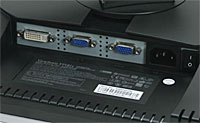 The 800:1 contrast ratio and 250 cd/m² brightness on offer served up vibrant and colourful images – in fact, we had to turn the monitor down from its default 100% brightness setting for fear of being permanently dazzled.
The 800:1 contrast ratio and 250 cd/m² brightness on offer served up vibrant and colourful images – in fact, we had to turn the monitor down from its default 100% brightness setting for fear of being permanently dazzled.
Viewing angles were also impressive, with horizontal viewing excellent up to 100° (50° from the centre of the image) and very good up to 160°.
We tested the monitors using a relatively elderly Gigabyte Radeon 9200 card with both digital and analogue outputs and found no real difference in quality between outputs.
Conclusion
We were mightily impressed with the Viewsonic VP191s.
Image quality was solid throughout, text was crystal clear and the 8ms response rate offered excellent coverage of fast moving images.
Add to that the slim-line bezel, good looks, sturdy stand and fantastic pivoting screen function and you have a monitor that stands out as one of the very best in its class.
We feel that the monitor provides an oustanding portfolio of specifications and features on offer for the money. Highly recommended.
Score: 5/5![]()
![]()
We’ve recently done a deal with PriceGrabber to offer readers of reviews the chance to buy the reviewed item directly.
We will get a small payment each time a link is clicked on.
 Mention the name “Commodore” to old skool gamers of a certain age, and you might see a tear welling up in their eyes as they recall long, blissful hours playing Frontier Elite, Sensible Soccer and Lemmings on the legendary gaming platform.
Mention the name “Commodore” to old skool gamers of a certain age, and you might see a tear welling up in their eyes as they recall long, blissful hours playing Frontier Elite, Sensible Soccer and Lemmings on the legendary gaming platform.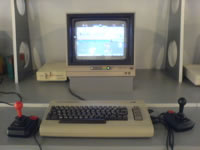 Codenamed ‘The Navigator Combo’, the Windows CE-based handheld comes with a 30GB hard drive (preloaded with maps), a big 3.6in touch-screen display and an integrated GPS receiver, all packed into a refreshingly chunky case.
Codenamed ‘The Navigator Combo’, the Windows CE-based handheld comes with a 30GB hard drive (preloaded with maps), a big 3.6in touch-screen display and an integrated GPS receiver, all packed into a refreshingly chunky case.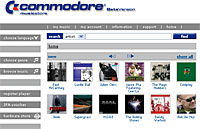 Videos can also be downloaded from the Internet or transferred from PCs via USB 2.0, or stored on SD memory cards.
Videos can also be downloaded from the Internet or transferred from PCs via USB 2.0, or stored on SD memory cards. The two companies presented a wide range of shiny new consumer electronic products for consumers and the retail market, including MP3/MP4-players, C64 gaming joysticks, multimedia download dispensers and home media centers.
The two companies presented a wide range of shiny new consumer electronic products for consumers and the retail market, including MP3/MP4-players, C64 gaming joysticks, multimedia download dispensers and home media centers.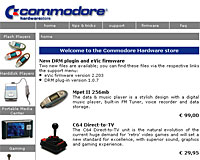 Building up to the required mutual backslap, he added, “Therefore the management of Yeahronimo and SupportPlus believe it is an obligation, when using the Commodore name, to continue offering the electronics consumer with products that have a high-quality and are attractive in price. SupportPlus already has showed they are an excellent partner in the historic re-launch of Commodore.”
Building up to the required mutual backslap, he added, “Therefore the management of Yeahronimo and SupportPlus believe it is an obligation, when using the Commodore name, to continue offering the electronics consumer with products that have a high-quality and are attractive in price. SupportPlus already has showed they are an excellent partner in the historic re-launch of Commodore.”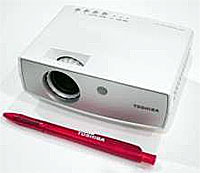 Promptly filed under “Gimme! Gimme! Gimme!” at first peek, Toshiba are debuting a portable LED pocket projector at the Internationale Funkaustellung (IFA) trade show 2005 in Berlin.
Promptly filed under “Gimme! Gimme! Gimme!” at first peek, Toshiba are debuting a portable LED pocket projector at the Internationale Funkaustellung (IFA) trade show 2005 in Berlin. Inside there’s a panel fitted with different coloured LEDs which serve both as the light source and the means to determine the colour of the projected images.
Inside there’s a panel fitted with different coloured LEDs which serve both as the light source and the means to determine the colour of the projected images.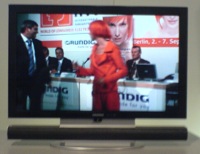 As with all companies at IFA, Grundig have shown a ton of new products, try to persuade the assembled throngs that they are approaching Digital Lifestyles by understanding the consumer.
As with all companies at IFA, Grundig have shown a ton of new products, try to persuade the assembled throngs that they are approaching Digital Lifestyles by understanding the consumer.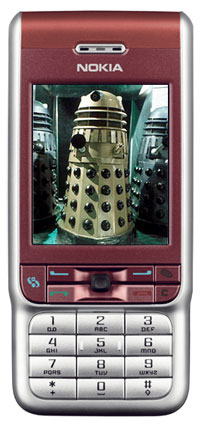 The BBC has announced that it will be offering classic episodes of “Doctor Who” and “Red Dwarf” on digital video chips for viewing on mobile phones.
The BBC has announced that it will be offering classic episodes of “Doctor Who” and “Red Dwarf” on digital video chips for viewing on mobile phones. Films can be fast forwarded, rewound and paused, just like a conventional movie player.
Films can be fast forwarded, rewound and paused, just like a conventional movie player. The first scheduled release is The Five Doctors, a 90-minute Dr Who special originally shown in 1983, followed by three episodes of cult sci-fi hit, Red Dwarf.
The first scheduled release is The Five Doctors, a 90-minute Dr Who special originally shown in 1983, followed by three episodes of cult sci-fi hit, Red Dwarf.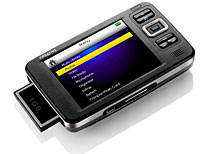 With the slap of a leather gauntlet against iPod’s shiny white face, Creative has unveiled its new Zen Vision a portable media player.
With the slap of a leather gauntlet against iPod’s shiny white face, Creative has unveiled its new Zen Vision a portable media player.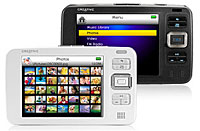 The Zen Vision supports a slew of video codecs, including AVI, DivX, XviD, MPEG-1, MPEG-2, MPEG4-SP and Microsoft’s WMV9.
The Zen Vision supports a slew of video codecs, including AVI, DivX, XviD, MPEG-1, MPEG-2, MPEG4-SP and Microsoft’s WMV9. Resplendent in its white or black finishes, the Zen is quite a looker, and is only slightly larger than the rival iPod.
Resplendent in its white or black finishes, the Zen is quite a looker, and is only slightly larger than the rival iPod.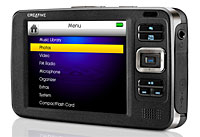 The pocket sized powerhouse comes with a rechargeable Li-ion battery offering up to 4.5 hours of video playback and 13 hours of audio, depending on the file’s format and energy settings.
The pocket sized powerhouse comes with a rechargeable Li-ion battery offering up to 4.5 hours of video playback and 13 hours of audio, depending on the file’s format and energy settings.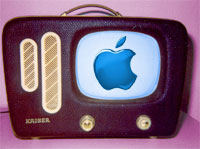 The rurmour mill continues to hum with speculation that Apple are set to introduce a video playing iPod-like device in the near future.
The rurmour mill continues to hum with speculation that Apple are set to introduce a video playing iPod-like device in the near future.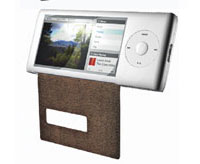 This has led to speculation that the company will be revising the iPod to create something like the ‘vPod’, a concept device created by design firm Pentagram which was published in Business 2.0 Magazine in March.
This has led to speculation that the company will be revising the iPod to create something like the ‘vPod’, a concept device created by design firm Pentagram which was published in Business 2.0 Magazine in March.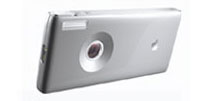 The big problem with trying to create a multimedia device is that people demand quite different things for mobile audio and video.
The big problem with trying to create a multimedia device is that people demand quite different things for mobile audio and video. First shown off at the CEATEC show in Japan last year, Sharp has announced that it will be launching its gargantuan 65inch LCD set in August this year – the biggest in the world.
First shown off at the CEATEC show in Japan last year, Sharp has announced that it will be launching its gargantuan 65inch LCD set in August this year – the biggest in the world.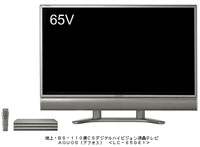 Monster LCD screens are prone to suffer from ‘smearing’, which results in onscreen artifacts being displayed by fast moving objects, but Sharp claims that its QS (Quick Shoot) Technology improves moving video responsiveness, making it perfect for watching high-speed full-motion video and fast moving footage (like a Cardiff City strike. Sort of).
Monster LCD screens are prone to suffer from ‘smearing’, which results in onscreen artifacts being displayed by fast moving objects, but Sharp claims that its QS (Quick Shoot) Technology improves moving video responsiveness, making it perfect for watching high-speed full-motion video and fast moving footage (like a Cardiff City strike. Sort of). As is often the case lust-spawning objects, there’s a double whammy of a sting for anyone fancying installing one of these monolithic beasts in their Hackney bedsit.
As is often the case lust-spawning objects, there’s a double whammy of a sting for anyone fancying installing one of these monolithic beasts in their Hackney bedsit. The London Underground is to show digital advertising on its escalators for the first time, as part of a trial being handled by Viacom Outdoor.
The London Underground is to show digital advertising on its escalators for the first time, as part of a trial being handled by Viacom Outdoor. The trial is due to start within months, and if successful will be rolled out at other locations across the network.
The trial is due to start within months, and if successful will be rolled out at other locations across the network. Apple has updated its iPod photo line-up with a new slim 30GB model, holding up to 7,500 songs, for just £249 ($475, e360) and a new 60GB model, holding up to 15,000 songs, for £309 ($590, e446)
Apple has updated its iPod photo line-up with a new slim 30GB model, holding up to 7,500 songs, for just £249 ($475, e360) and a new 60GB model, holding up to 15,000 songs, for £309 ($590, e446) The truth is that the iPod photo seems to be far better as a versatile MP3 player and photo presentation unit rather than something for serious photographers to use for direct-to-camera storage.
The truth is that the iPod photo seems to be far better as a versatile MP3 player and photo presentation unit rather than something for serious photographers to use for direct-to-camera storage.